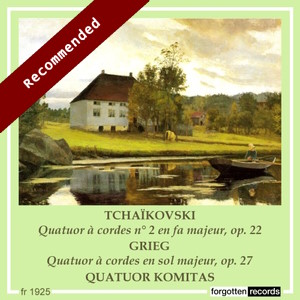
Pyotr Tchaikovsky (1840-1893)
String Quartet No. 2 in F major, Op. 22 (1874)
Edvard Grieg (1843-1907)
String Quartet in G minor, Op. 27 (1878)
Quatuor Komitas
rec. 1952 (Grieg), 1954 (Tchaikovsky), Moscow
Forgotten Records FR1925 [70]
The Komitas Quartet was formed by four virtuoso Armenian students at the Moscow Conservatory in 1924 and their name, Komitas, was awarded to them by the Armenian government in 1934. Although the Beethoven Quartet had been formed two years earlier, they broke up in 1987, leaving the Komitas, still playing but obviously with different personnel, as the oldest existing string quartet in history. On their foundation, Mikhail Ippolitov-Ivanov, the distinguished Russian composer and rector of the Conservatory declared, “This young quartet will take a leading position very soon” and that prediction was almost instantly realised, as the ensemble quickly became one of the finest string quartets in the Soviet Union, giving concerts all over the country and in eastern Europe. They later taught at the Conservatory.
The great Armenian composer, musicologist, monk and choir master Komitas Vardapet Soghomon Soghomonyan (1869-1935), led the renaissance of Armenian music in the 20th century. At the core of the Komitas’ repertoire were the works of young emerging Armenian composers Mirzoyan, Arutunyan, Khudoyan, Mansurian, Oganesyan, Spendiarov, but also the classical quartets by Beethoven, Schubert and Mendelssohn. They also recorded Armenian songs by Komitas arranged by Aslamazyan, and premiered and recorded quartets by Soviet composers including Lokshin, Golubev, Prokofiev, and Shostakovich; these recordings are now sought after by chamber music aficionados.
The Komitas Quartet plays here the Second Quartet, the less familiar of Tchaikovsky’s four string quartets. It dates from 1874 when the composer had settled into a more comfortable lifestyle, teaching regularly at the Conservatory while writing his opera Vakula the Smith and the Second Symphony. The first movement, Adagio, opens with a melancholy reverie led by Avet Gabrielian’s first violin, immaculately decorating a beautiful theme. As other instruments pick up the idea the tempo increases, and the players demonstrate an impressive unity in this impeccably written movement. The Allegro giusto, with its irregular rhythms such as the 7/4 typical of Russian folk music, is impressively played. Most striking is the Trio, with its charming waltz concluding con fuoco. The Andante ma non troppo is a rondo reprising the first movement idea, leading to a fresh, second idea by Gabrielian, who is assisted by the great virtuosity of Henrik Talalyan on the viola, before the dream-like conclusion. The finale, Allegro con moto, combines a dazzling range of themes and variations played with consummate mastery by all four virtuosi, each relishing the magnificent little fugue constructed around the first idea, building excitement throughout up to the exuberant coda. The original recording by Melodiya is vibrant; each instrument may heard clearly be heard without any hint of distortion.
Of Grieg’s three quartets, Op. 27 is the only one which has become a firm part of the quartet repertoire. It dates from a richly productive period in his career and from the same decade as Tchaikovsky’s Second Quartet. It was recorded two years previously – not as clearly as the Tchaikovsky quartet, but that does not detract from the listener’s enjoyment of a superb performance of this masterwork.
The opening theme in the first movement, Un poco Andante – Allegro moderato ed agitato, is from the composer’s song Spillmaed (Minstrel). The ensemble play immaculately in unison. The intensity of the first theme dominates before the second beautiful idea is launched by Gabrielian and moves into a series of variations exchanged among the players. In the second movement, Romanze: Andantino – Allegro agitato, Sergey Aslamazyan’s cello announces an evocative theme which is picked up eloquently by his colleagues, each player bringing out its colours and harmonies without sentimentality.
The strident, potent idea of the third movement, Intermezzo: Allegro moderato marcato – piu vivo e scherzando, is played magnificently in unison, leading to Gabrielian introducing a child-like theme which becomes more intense when taken up by the other instruments. A tuneful, folk-like harmony from Talalyan on the viola heralds a merry climax. In the finale, the violins announce a sad idea which turns fateful, then Gabrielian introduces a briskly exciting theme before an exploration of variations leading to a brilliant, life-enhancing close.
There are no notes, only details of the original issues on Melodiya, Columbia and Angel LPs from which this CD was re-mastered and of the websites giving more information about the ensemble. This disc is obligatory for aficionados of 20th century string quartet playing.
Gregor Tassie
| Availability |  |
Quatuor Komitas: Avet Gabrielian (1st violin), Levon Ohanjanian (2nd violin), Mikhail Terian (viola) & Sergey Aslamazyan (cello)


















